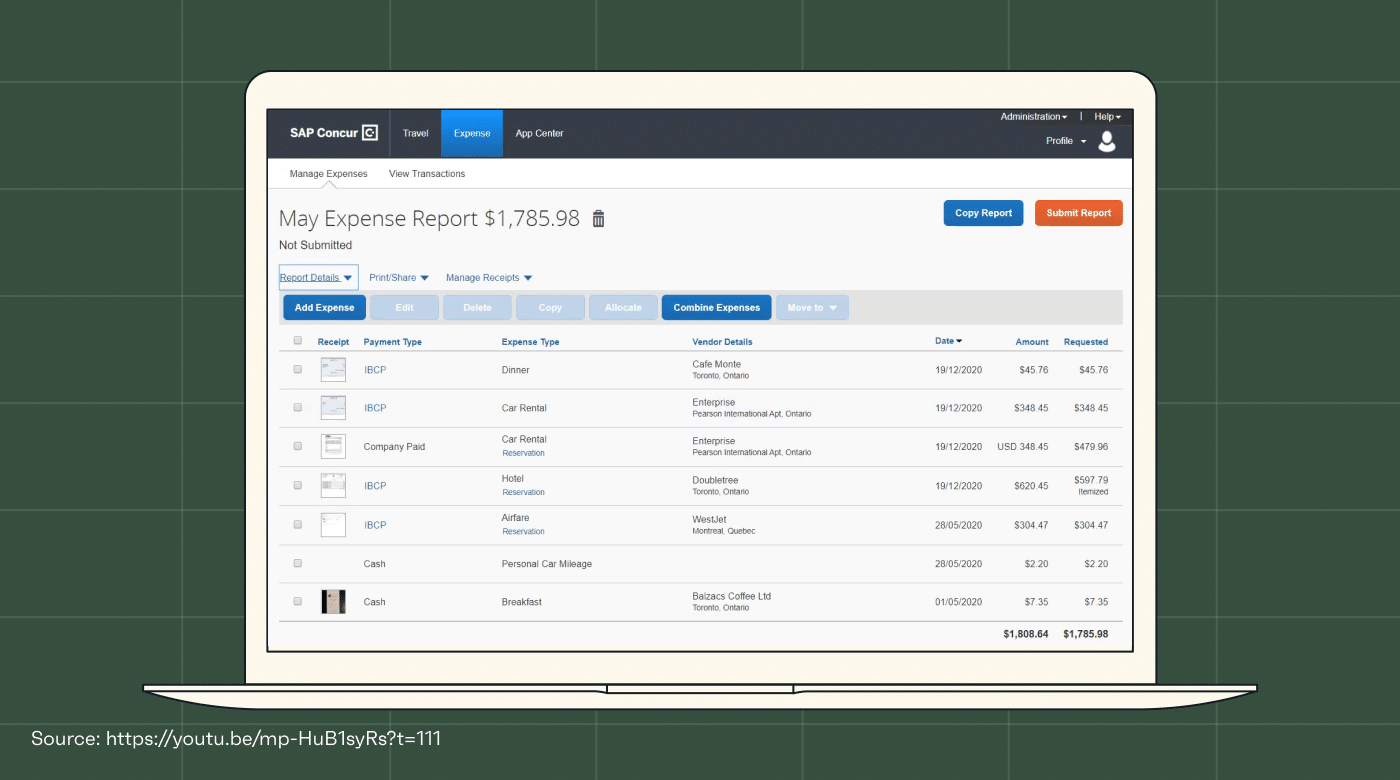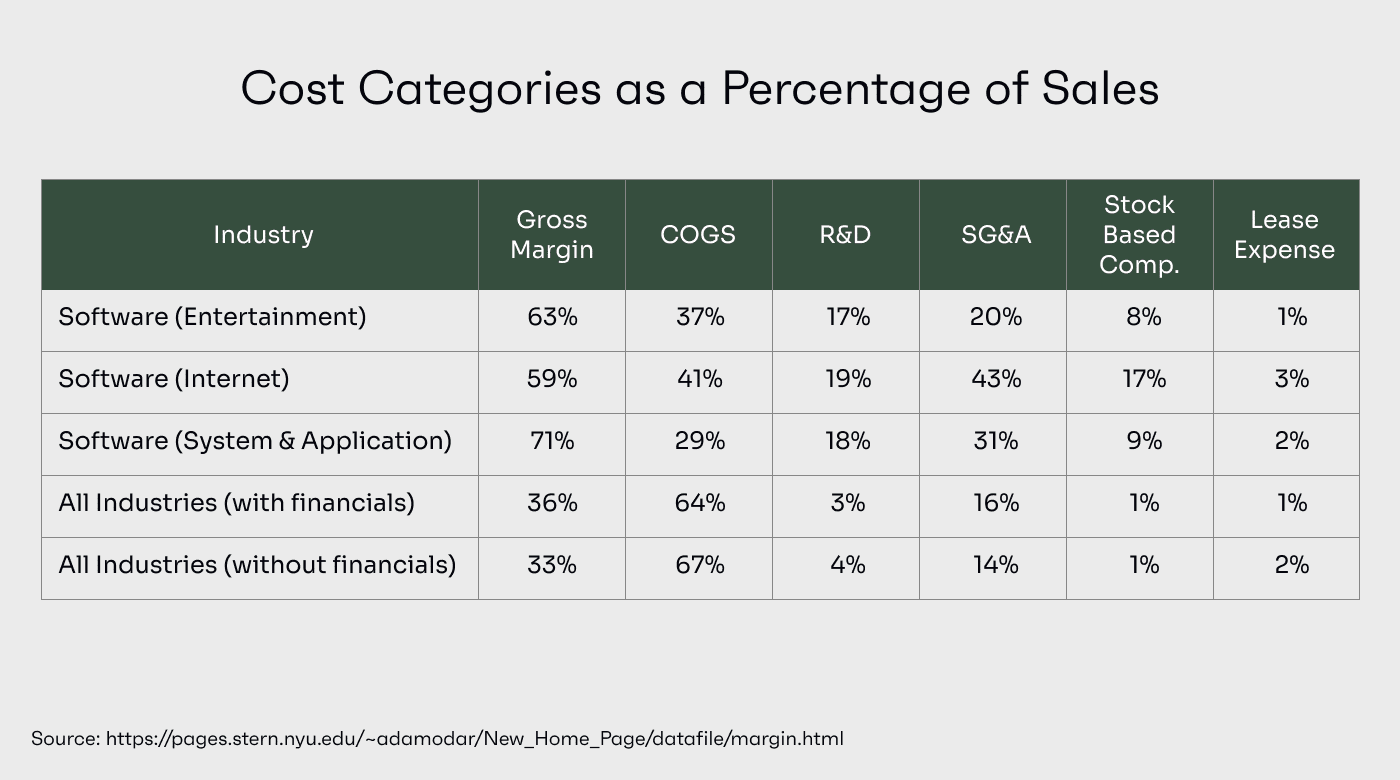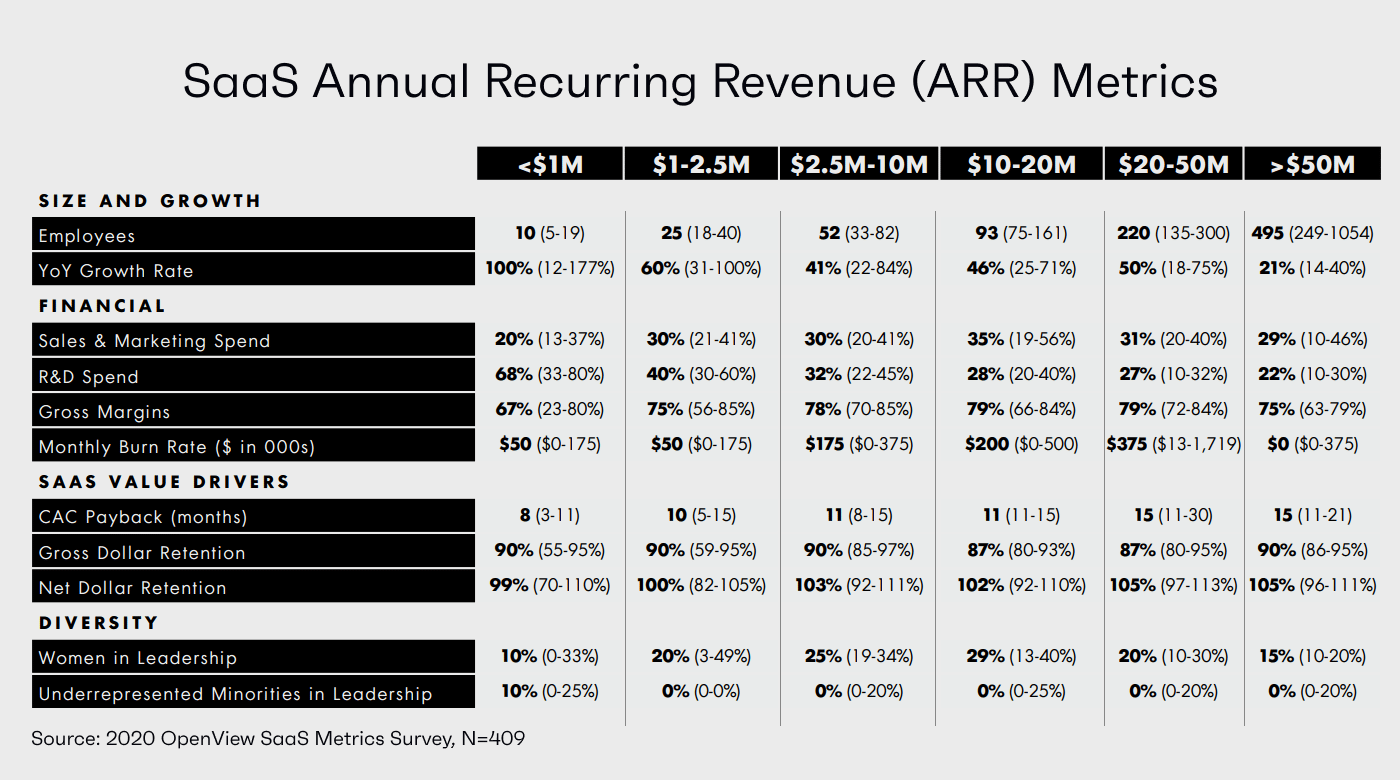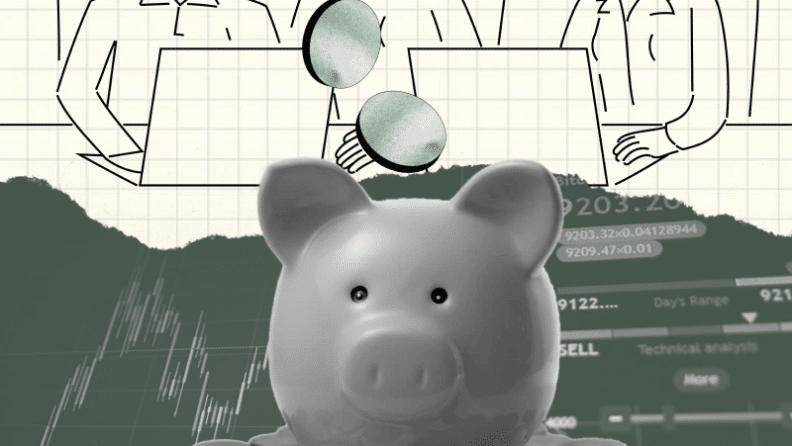Gross margin is a key financial metric for just about any firm, in any industry. Businesses in the software-as-a-service world are no different—but SaaS gross margin expectations are a bit different for SaaS firms than they are for other types of companies.
Understanding gross margin is key to analyzing a company’s financial performance. You can use it for everything from calculating an appropriate price markup to identifying underperforming departments and informing overall business strategy—but first, you need to understand the basics.
What is Gross Margin?
Gross margin is a profitability measure that compares a company's profit margin to its sales revenue. It’s a quick way to measure incremental profit after subtracting direct costs from sales revenue. It tells you the amount of gross profit earned on every dollar of revenue.
Gross margin is expressed as a percentage of revenue. You can calculate it on a time basis, or even for a single sale.
The formula for gross margin is:
Gross Margin = COGS Revenue ÷ Revenue
The classic example is a retailer: If a store sells a $200 product that costs $170 to produce, its gross profit is $30, which means its gross margin is 15% ($30/$200).
Note: This simplified example looks at a gross margin on a product level, but it can also be calculated for an individual department, geographic region, or operating segment.
Cost of Goods Sold (COGS) vs. Cost of Sales (COS)
Obviously, SaaS firms and other service companies don’t sell physical products. So, the term “cost of goods sold” doesn’t really fit.
Instead of COGS, SaaS firms may use Cost of Service (COS), Cost of Sales (COS), Cost of Revenue (COR), or Cost of Subscription Revenue (COSR). The concepts are the same as COGS but these terms tend to fit SaaS businesses a bit better - for that reason, I'll primarily use Cost of Sales (COS)
How to Calculate SaaS Gross Margin
I covered the formula above but in case you skipped it, here's a refresher: Gross Margin = (Revenue - Cost of Sales) / Revenue.
For a SaaS firm, the main components of Cost of Sales are typically licensing, hosting, cloud storage, and certain personnel costs. I'll go deeper into this later in the article.
When calculating Cost of Sales, finance teams may pull in data from expense tracking software or general accounting software.
Revenue for a SaaS firm includes:
- Recurring subscription revenue
- Add-on services
- Integration services
- Paid support tiers
- Custom development or integration fees
Revenue is everything earned from customers. That means revenue can include software subscriptions, contract development work, custom integration fees, and even lemonade sales if the vendors are your employees.
The same gross margin formula is used regardless of the type of company. For many software firms and other service-based companies, the non-obvious bit is how to calculate Cost of Sales (COS).
What’s Included in a SaaS Company’s COS Calculations?
Any costs that are necessary to allow your customers to continue using and accessing your software will be included in COS. Any other costs will be excluded.
Cost of Sales includes the direct costs of providing services to customers (in this case, software subscriptions). Cost of Sales can include direct labor costs (the salaries of your software engineers who created or designed your product), hosting costs, and an allocated percentage of general overhead costs.

Cost of Sales (COS) for SaaS firms includes:
- Hosting costs
- Website hosting and maintenance costs
- Licenses for third-party apps and modules
- Customer onboarding costs
- Subscription costs for running products
- Direct labor
- Allocated overhead and other direct costs
Cost of Sales does not include any indirect operating costs and administrative expenses, nor does it include marketing expenses. Commissions—for instance, affiliate payouts—may or may not be included but I recommend keeping them out.
Cost of Sales for SaaS firms excludes:
- Product development costs
- Commissions
- Marketing costs
- Legal fees
- Capital expenditures
- Administrative and indirect costs
- Indirect operating expenses
- Amortization expenses
- Stock-based compensation expenses
- Employee benefit costs
If the cost isn’t directly related to the SaaS product, you don’t include it in COS or gross margin calculations.
Calculating Gross Margins with Annual Recurring Revenue
As mentioned, gross margin calculations typically look at total revenues vs. total direct costs on an enterprise level.
However, in the SaaS industry, it can sometimes be more helpful to look at annual recurring revenue (ARR) rather than total revenue.
ARR looks at recurring revenue from subscriptions and licensing deals, excluding one-off and non-recurring revenue sources (like implementation packages).
For a SaaS firm, ARR margins provide a more accurate view of the effects of additional subscription revenue. By excluding non-recurring revenue, firms can gain a clearer picture of gross profit margins on each additional dollar of ARR.
To conceptualize, it’s helpful to look at an example where ABC Company earns $500,000 in non-recurring revenue, in addition to $4,000,000 in recurring revenue:
- Total revenue = $4,500,000
- Recurring revenue = $4,000,000
- Direct costs = $1,500,000
Given these assumptions, ABC Company’s calculations would produce the following results:
- Gross margin = 66.7%
- ARR margin = 62.5%
If I were an investor looking at your books, I'd be much more interested in the ARR margin.
What's a Good SaaS Gross Margin?
A good SaaS gross margin can vary highly, depending on the growth stage of the company. Early-stage firms are typically going to face higher costs relative to revenues and therefore have lower margins, while more established firms typically benefit more from economies of scale.
For a frame of reference, we can look at industry averages.
2023 data from the NYU Stern School of Business shows software firms have, on average, gross margins of between 58.92% and 70.92%, with generally higher margins in firms operating in system and application software. The same dataset shows that the average of all the firms surveyed (across dozens of industries) was 36.28%.
SaaS margins are quite high compared to other industries—practically double.
If we know that the average gross margin for SaaS firms operating in the system and application software industry is over 70%, we’ll say a good SaaS margin is anything above that.
There’s some data to back that up. A SaaS Benchmarks study from 2020 found that 70% of the 400+ companies surveyed had gross margins of 70% or more, and top performers had gross margins of 80%+.

Of course, it'll depend on the growth stage of the company, the sub-industry, and other factors.
But suffice it to say SaaS firms face much higher expectations for gross margins than companies in other industries.
Expected Gross Margins by Industry
For some context, take a look at the average gross margins of the industries shown below:
| Industry | Gross Margin |
|---|---|
| Advertising | 29.17% |
| Apparel | 51.84% |
| Education | 46.61% |
| Electronics | 27.35% |
| Food processing | 24.63% |
| Homebuilding | 27.32% |
| Oil and gas production | 64.45% |
| Real estate development | 32.51% |
| Software (entertainment) | 63.23% |
| Software (internet) | 58.92% |
| Software (system & application) | 70.92% |
| Telecom services | 55.53% |
| Trucking | 27.26% |

Investors expect high margins from SaaS firms, particularly from established SaaS firms. This is relevant for pricing strategies and even more vital for securing funding.
Why is Understanding Gross Margin Important for SaaS Businesses?
Gross margin can help SaaS teams monitor financial performance, analyze operations, and make more informed business decisions. It’s a versatile metric that can be used in a number of scenarios, like:
- Finding the right price point to get your target profits
- Better understanding your reinvestment priorities
- Attracting top investors, and
- Figuring out just how big of a bonus you should be earning
Below, I’ll go over some of the key areas where SaaS gross margin can impact your business.
It’s a Key Valuation Metric for Investors
External investors will look at a range of different financial and performance metrics in their due diligence process. Gross margin says a lot about how well an organization is running and its ability to turn a profit. This is one of the first things that most investors and VC firms will check.
Investors use gross margin to gauge the financial performance of a firm at different stages of its lifecycle. It can also be used by firms as an internal benchmark, or in comparison to competitors.
If you’re looking for SaaS funding for your firm, having solid gross margins is a must.
It Helps with Finding the Right Price Point
Determining pricing for SaaS products can sometimes feel like you’re shooting blind, especially if you’re first to market or dealing with a very specialized product.
By taking a finance-first approach, you can choose a target gross margin (say, 80%) and work backward from your cost of service per unit to find your target selling price.
Selling Price = Cost of Service (per unit) ÷ (1 - Gross Margin)
Assume your cost of service per unit is $100, and you want an 80% gross margin. You can calculate the target selling price as shown below.
Selling Price = $100 ÷ (1 - 0.8) = $100 ÷ 0.2 = $500
Of course, most SaaS firms will have multiple tiers of service. You’ll need to run the numbers to determine appropriate price points for each service level, then conduct market research - such as a Van Westendorp pricing survey - and check out comparables to ensure your pricing is competitive.
It Improves Cost-Benefit and Reinvestment Potential Analysis
A key application of gross margin is in cost-benefit analysis, particularly in relation to marketing spend, internal commissions, and affiliate commissions.
Gross margin shows you how much gross profit can be estimated from each additional dollar of gross revenue.
So, if you have hard numbers for commissions or ad buys (along with estimated conversion rates), you can get a pretty good idea of the potential ROI of any given campaign.
You can also use gross margin figures to evaluate reinvestments in existing or new projects or even weigh the pros and cons of investing internally vs. externally.
How do SaaS Gross Margins Differ in Different Growth Stages?
We can see from the data that industry-standard SaaS gross margins are typically in the 60-80% range.
Obviously, a firm’s revenue and costs have the most direct impact on gross margin. But what’s less apparent is that, on average, gross margins tend to improve over time—up to a point.
In a 2020 SaaS Benchmarks study, respondents from over 400 SaaS firms were surveyed. The researchers found that the smallest firms (<$1m ARR) had the lowest gross margins, with an average of 67%.

Gross margins steadily increased alongside revenues from there, with the exception of firms running over $50m ARR. Gross margins at the SaaS firms surveyed were:
- 75% for <$5m ARR
- 78% for <$10m ARR
- 79% for <$20m ARR
- 79% for <$50m ARR,
- 75% for >$50m ARR
There will, of course, be outliers here, but the data is clear that more established firms with higher ARRs tend to run higher gross margins, up to a point.
If you want to see more benchmarks, check out our 2023 gross margin benchmark report.
How to Improve SaaS Gross Margin
Higher gross margins can improve the financial health of your firm, attract investors, and even make it easier to test new strategies and products. But how do you improve your gross margins?
Well, the basics are obvious: You need to either increase revenue, decrease costs, or both. Here are some specific strategies you may wish to explore.
Increase Revenue
Increasing revenue is a primary goal of all businesses, so this is nothing new. But when it comes to driving better gross margins, here are some specific strategies to experiment with.
Experiment with Different Pricing Models
The main lever you can pull to increase revenue is, naturally, changing your subscription prices. The obvious approach is to simply raise prices—but that’s not the only way to drive revenue increases.
For instance, some firms are utilizing consumption-based pricing instead of flat rates. In fact, many of the most well-known SaaS providers, like Snowflake, AWS, and Google Cloud are all using consumption-based pricing.
This pricing strategy charges customers based on their usage patterns. That could mean charging based on storage used, API calls made, number of active users, etc., depending on the type of software.
Consumption-based pricing, also called usage-based pricing (UBP), is more common than you might think. A 2022 report found that 3 out of 5 SaaS firms surveyed were using UBP strategies, and that figure is expected to grow.
It appears to be working, too. Firms employing usage-based pricing models saw year-over-year revenue growth outpace the rest of the market by 31% in 2022.
Of course, it doesn’t have to be strictly subscription model vs. usage-based pricing. Many firms offer both, offering customization options that allow clients to put together their own packages to meet usage needs.
In some cases, firms can keep things simple by just raising prices. In this inflationary environment, firms and consumers alike are growing accustomed to price increases. Moderate price increases should be well tolerated by customers—particularly if they’re announced alongside the addition of new features.
Striking the right balance in your pricing strategy can be complex, but I’ve got you covered here in my guide to SaaS pricing strategies.
Broaden Market Penetration
SaaS firms often target highly specific segments of the market. And with competition fierce, this certainly makes sense—and the approach tends to work.
With that said, once the product is well established, opportunities exist to expand beyond the initial target market.
For instance, an enterprise SaaS tool might release a limited-feature freemium version that’s approachable for small- and medium-sized businesses. Or a consumer SaaS tool may choose to expand internationally or launch multi-language support.
Reduce Churn Rate
The churn rate is the percentage of customers who stop using a product or cancel their subscriptions over a given period of time.
Some level of churn is inevitable. But churn rates can be a huge driver of revenue shifts. If churn rates are too high, margins will be pinched and revenue inconsistent.
Typically, a churn rate of 5% or less is seen as acceptable in the SaaS industry.
There are many approaches you can take to improve SaaS churn rates. Customer education and engagement is a big one. By ensuring your customers know how to make use of your product, you can reduce the likelihood of churn. Customization, improving customer service, and helping clients with onboarding are other key ways to reduce churn.
Focus Efforts on High-Profit Products
Gross margins are often calculated enterprise-wide, but there’s often benefit in running product-specific calculations as well.
By identifying the most profitable product mix, firms can better utilize their resources—whether that’s marketing spend, R&D funds, or project management.
And really, there are two approaches here: Double down on your most profitable markets or dedicate more resources to underperformers. Either approach can theoretically increase revenue and improve margins—it just depends on your specific situation and how big of a performance gap there is between each product offering.
Explore Affiliate Partnerships
Affiliates in the SaaS industry can drive significant subscription revenue growth. Yes, of course, there’s a significant cost to paying out affiliate commissions, but working with top affiliates can increase brand awareness and drive sales.
Be aware, however, that commissions and marketing costs are typically not included in gross margin calculations. If you increase spending on affiliate marketing, that can boost revenue without increasing COS, which boosts gross margins but not necessarily net profits.
Decrease Costs
Conversely, the other main lever to improving margins is decreasing direct costs.
As a reminder, the only costs that go into gross margin calculations are those that apply directly to the product or service. If the cost is essential to providing that service, it’s included; if it’s a general or administrative cost, it’s excluded.
For many firms, the biggest cost drivers are third-party tools and apps included in software offerings, hosting and web services, and labor costs for certain teams (DevOps, customer support, and professional services).
Anything you can do to reduce costs in your primary cost drivers can help improve margins. However, be cautious about aggressive cuts—for example, outsourcing customer support could save money but could also increase churn if it frustrates customers.
Here are some outside-the-box cost-saving strategies to consider.
Prioritize High-Efficacy R&D Endeavors
Ongoing R&D is vital to success in the SaaS industry. But when dealing with a limited budget, it’s important to prioritize efficiently.
For instance, say you’re planning new features to stay competitive with other tools on the market. That’s great, but do you know what features your customers actually want and need? Are you capturing customer usage data or even exit data when a customer cancels their subscription? Are you adding features solely because a competitor did or because those features are actually in demand from your target market?
It is absolutely true that a product-led approach can help SaaS firms differentiate themselves, build loyalty, and protect margins. But it’s wise to ask yourself questions (and ask your customers questions, for that matter) about what features or projects are the most worthwhile.
If your team is facing a wide variety of potential projects, breaking them down into categories can be helpful. Categories might include customer requests, platform improvements, sales prospects, etc.
Then, assign priority based on each project’s estimated impact to the metrics that matter most to your firm. Run detailed cost estimates to better gauge the investment needed, and then run cost/benefit analysis on each potential project.
Optimize Your Software Supply Chain
Many SaaS firms will utilize third-party software in their product offerings. Whether that’s hosting products on AWS or integrating third-party licensed tools directly into your own product, these costs can really add up.
For things like hosting, the obvious cost-cutting approach is to shop around for the best deal. Downtime is a concern that keeps many firms from jumping ship, but the reality is that service providers are keen to help speed up migration and keep downtime to an absolute minimum.
Integrations and bundled product offerings are another potential significant cost driver, in more than one way. Licensing costs can obviously add up, and certain integrations can also increase the complexity of delivering software to customers and therefore drive higher DevOps costs.
If you can simplify your software stack, you can reduce costs and increase efficiency for your teams. Better yet, improving the functionality of your own product to reduce reliance on third-party integrations can both save costs and drive better retention rates, as customers get a better value.
Share Start-up Costs with Customers
Implementation, onboarding, and initial deployments can be huge cost drivers, particularly for firms serving larger companies or customers with complex deployments. The bulk of the cost is in labor, which is sometimes overlooked as a cost driver. Have you considered how many employee hours a typical implementation is costing your team?
For a long time, SaaS firms have been okay with eating these costs and providing free support and integration deployment. But that’s been part of the growth-at-all-costs model, which is certainly shifting in this economic environment.
If you’re serving enterprise customers, or even small- and medium-sized businesses, sharing these initial costs is completely appropriate. In most cases, that would look like a flat fee surcharge for new customers.
Gross Margin is a Key SaaS Metric
In the SaaS world, gross margins tend to run much higher than in most other industries. Averages are in the 60-70%+ range, with a good SaaS gross margin considered to be between 70% and 80%+.
There are many steps that firms might consider to improve gross margins, including implementing new pricing strategies, cutting costs, or reducing churn. But it all starts with calculating your firm’s own gross margin and comparing it to industry averages.
Want more insights from leading SaaS finance professionals? Join The CFO Club newsletter to compound your abilities and insights as a finance leader.


